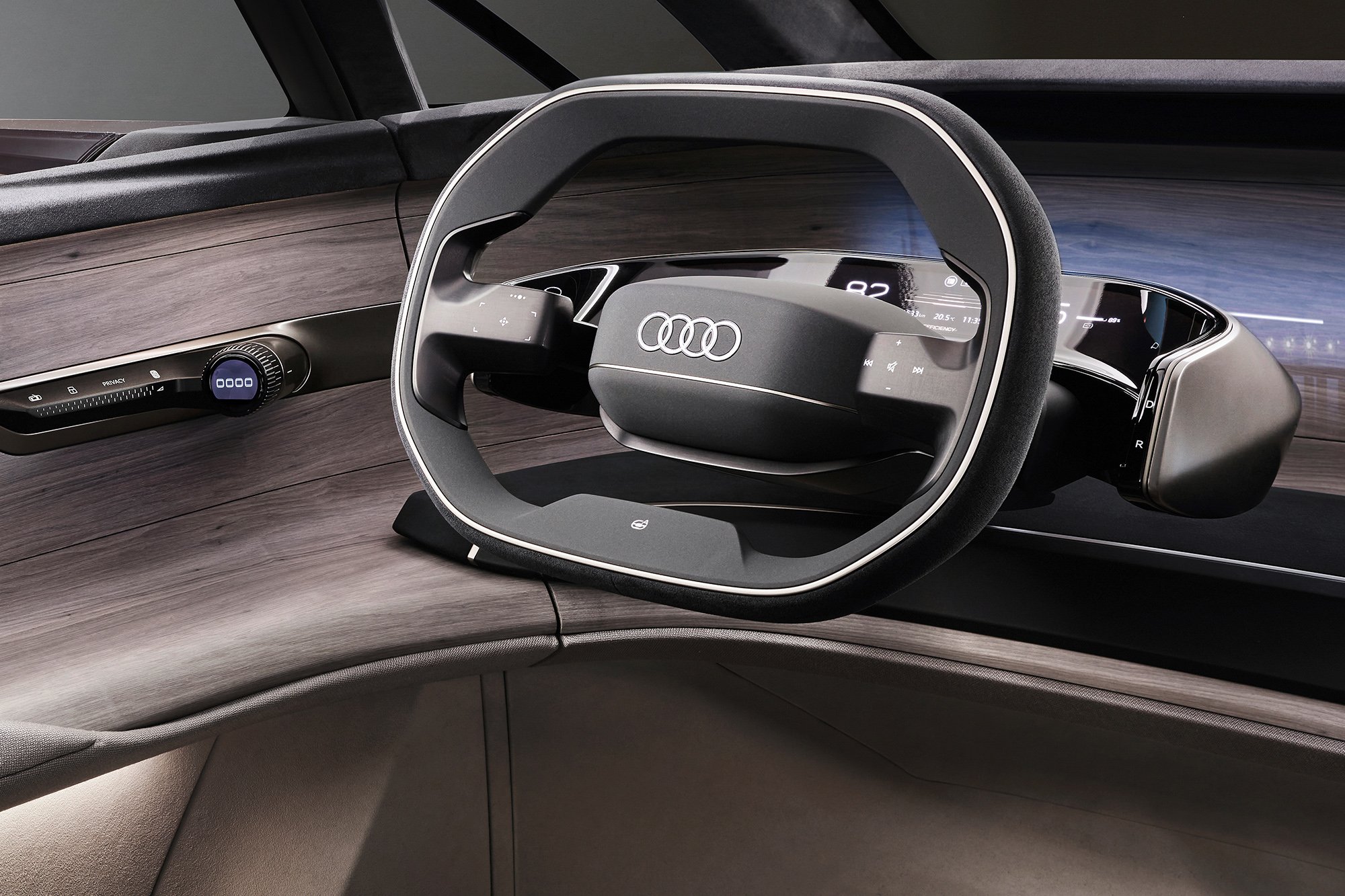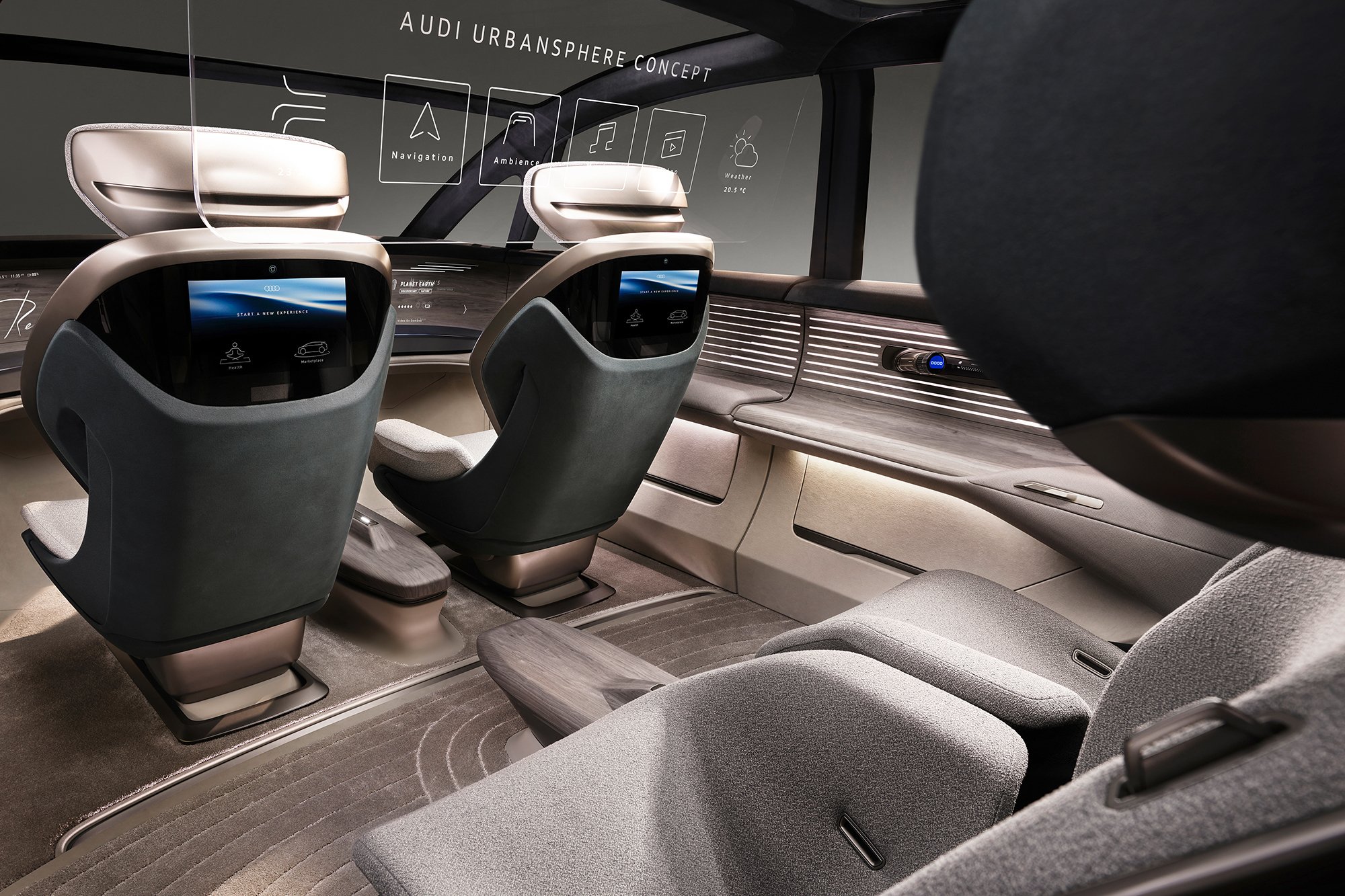The Audi urbansphere concept – a new luxury for megacities
After unveiling two of its three “sphere” concept cars in 2021, the Audi skysphere and grandsphere, their last and long-awaited concept car is finally here, the Audi urbansphere – a luxury vehicle designed for urban centres and the megalopoles of the world. In these urban areas where personal space is in particularly short supply, the concept car offers the largest interior space of any Audi to date. It combines this with technologies and digital services that appeal to all the senses and offer a whole new level of experience.
Designed for Chinese megacities
The concept car was originally designed for traffic-dense Chinese megacities, where space is of the essence.
“In order to meet the demands of our Chinese customers, Audi’s design studios in Beijing and Ingolstadt worked together closely to jointly develop the Audi urbansphere concept car. For the first time, potential customers in China could also take part in the development process, contributing their own desires and perspectives as part of a process known as “co-creation”. – Markus Duesmann, Chairman of the Board Management at Audi AG and responsible for the Chinese market
As a result of this participative process, the Audi urbansphere concept has a particularly striking interior. The spacious automobile acts as a lounge on wheels and a mobile office, serving as a third living space during the time spent in traffic. To this end, the Audi urbansphere combines the luxury of complete privacy with a comprehensive range of high-tech features on board, even during the daily rush hour. Automated driving technology transforms the interior, in which a steering wheel, pedals, or displays are notably absent, into a mobile interactive space that provides a gateway to a wider digital ecosystem.
Luxury revisited
The three concept cars, Audi skysphere, Audi grandsphere and Audi urbansphere were developed to share the brand’s vision of what premium mobility looks like in the future. With this goal in mind, Audi is creating a vehicle experience that goes far beyond the purpose of merely spending time in a car to get from point A to point B.
First, the electric Audi skysphere, a self-driving GT that transforms into a self-driving sports car with a variable wheelbase. Then, the Audi grandsphere which shortly followed suit, a large four-seater sedan showcasing the brand’s ambition to define the future of progressive luxury.
What these two predecessors share with the Audi urbansphere is that the entire concept is based on level 4 autonomous vehicle technology. Audi is currently working with CARIAD, Volkswagen Group’s software business, to introduce this technology within the second half of the decade.



The interior
The “sphere” in the name of the Audi urbansphere sends a signal: the heart of the Audi skysphere, grandsphere, and urbansphere concept vehicles lies in its interior. That makes the inner space the foundation of the vehicle’s design and technology and therefore the occupants’ living and experience sphere while on the road.
The Audi urbansphere is the largest model in the sphere family and of all Audi concept cars to date, with its 5.51 metres (18 feet) length, 2.01 metres (6.6 feet) width, and 1.78 metres (5.8 feet) height. At the same time, the model truly breaks conventions of the automotive industry with its systematically passenger-oriented design: most significantly the dimension of the unrivalled wheelbase of 3.40 metres (11.2 feet).
The interior of the Audi urbansphere is not subject to the conventional maxim of squeezing as many seats, storage compartments, and functional elements as possible into a space limited by the physics of driving. Instead, it prioritises the occupants’ need to experience ample space as a distinctive comfort factor.
“To make e-mobility even more attractive, we think about it holistically and from the customer's needs,” said Markus Duesmann. More than ever before, it is not just the product that is decisive, but the entire ecosystem, which is why Audi is incorporating the car’s services into a comprehensive ecosystem resulting in an “experience device” rather than a mere vehicle.
Because the passengers are so central in the crafting of this experience, this also creates a shift in the design process itself – at the beginning of all discussions, the focus is solely on the interior. Only then are the package, exterior lines, and proportions designed, along with the technological specifications, turning the automobile into a complete work of art.
Not only do the urbansphere’s impressive dimensions provide ample space, the four individual seats in two rows offer passengers luxurious first-class comfort. The seats in the rear offer particularly generous dimensions and a wide range of adjustment options: in Relax and Entertain modes, the backrest can be tilted up to 60 degrees while leg rests extend at the same time.
The centre-mounted armrests integrated into the sides of the seats and their counterparts in the doors create a comforting feeling of security. The seats also cater to passengers’ changing social needs in a variety of ways. While conversing, they can turn to face each other on their swivelling seats. On the other hand, those who want some seclusion can conceal their head area from the person sitting next to them using a privacy screen mounted behind the headrest.
The exterior
The body’s silhouette features traditional Audi shapes and design elements, combined with the distinctive Singleframe, the digital eyes of the adjacent lighting units, a widely curved and dynamic roof arch, a massive rocker panel that conceals the battery unit, and large 24-inch six double spoke wheels which all result in a new composition. The implied wedge shape of the vehicle body is emphasised by the large, flat windshield. At the front and also at the rear, there are large digital lighting surfaces that leave their mark on the design and at the same time serve as communication elements.
The similarities to the Audi grandsphere concept are particularly eye-catching. The monolithic design of the vehicle body shares commonalities with these two concept cars, as do the sculpted, soft shape of the wheel arches. A long wheelbase of well over three metres (9.8 feet) and short overhangs indicate that this is an electric vehicle. Elegance, dynamism, an organic design language – these are the attributes that immediately spring to mind despite the stately proportions of the Audi urbansphere, just as they do in the significantly flatter grandsphere.
The innovative interpretation of the Singleframe, shaped like a large octagon, defines Audi’s look. Even though the grille has lost its original function as an air intake on the EV, it still remains prominent as an unmistakable signature of the brand. The digital light surface lies behind a slightly tinted, transparent visor that covers a large area of the front, and the three-dimensional light structure itself is arranged in dynamically condensed pixel areas. The entire surface of the Singleframe becomes a stage or canvas (known as the “Audi Light Canvas”) and can be used for communication – with dynamic lighting effects to clearly signal to other road users in order to improve road safety.
Tech & connectivity
The Audi urbansphere comes to life at the touch of a fingertip with many displays, including projections on the wooden surfaces below the windshield, which may come as a surprise. Depending on the driving status, they are either distributed across the entire width of the interior or segmented for the driver and front-seat passenger, displaying all of the necessary travel information in ultra-high resolution throughout the journey. In addition, a sensor bar is integrated under the projection surfaces for quick switching between content, which shows all the functions and applications that are active in the car.
One particularly innovative control element is located near the door cut-out on the interior cladding: the MMI touchless response. If the passenger is sitting in the upright position, far forward in their respective area, they can use this element to physically select various function menus via a rotating ring and buttons and click their way through the individual levels, allowing for simple and intuitive operation.
Whether it is eye-tracking, gesture or voice control, or touch, the same thing applies to all operation modes: the Audi urbansphere concept adjusts to the individual user and learns their preferences and frequently used functions – and on that basis, it can not only sensibly complete rudimentary commands but also give personalised suggestions directly to the user. Here once again, we can clearly see the user-centric design process of the vehicle, showcasing another forward-thinking concept for the future.
Sustainability
Of course, the concept car is fully electric, which is in and of itself a great step towards sustainability, but it doesn’t stop there – materials were also a big point of emphasis in terms of the vehicle’s sustainability.
Most of the vehicle’s materials, such as the hornbeam veneers, come from sustainable sources. This choice of material makes it possible to use wood that has grown close to the site, utilising the entire trunk and therefore cutting waste. Additionally, no chemicals are used during the manufacturing process. The seat padding is made of ECONYL®, a recycled polyamide that can also be recycled after its use in the automobile – without any loss of quality. Lastly, bamboo viscose fabric is used in the armrests and in the rear of the vehicle. Bamboo grows faster than ordinary wood, sequesters a great deal of carbon, and doesn’t require herbicides or pesticides to grow.
Drive system & charging
The Audi urbansphere runs on the Premium Platform Electric (PPE platform), which was designed exclusively for battery-electric drive systems. The key element of the PPE is a battery module between the axles, which holds around 120 kilowatt hours of energy. An impressive feat is also that Audi has succeeded in achieving a flat layout for the battery by using almost the entire base of the vehicle between the axles.
The Audi urbansphere concept’s two electric motors are capable of delivering a total output of 295 kilowatts and a system torque of 690 newton metres. These are impressive figures that are often not fully utilised when driving in dense urban traffic. The heart of the drive system is the 800 volt charging technology. It ensures that the battery can be charged with up to 270 kilowatts at fast-charging stations in the shortest possible time. As such, charging times approach those of a conventional stop to refuel a car powered by an internal combustion engine: just ten minutes are enough to charge the battery to a level sufficient to power the car more than 300 kilometres (186 miles).
In addition, the battery, which holds more than 120 kilowatt hours, can be charged from five to 80 percent in less than 25 minutes. This means that a range of up to 750 kilometres (466 miles) can be expected according to the WLTP standard – and even when used for more energy-intensive city and short-distance trips, it is generally possible to avoid making unexpected stops to charge.
Overall, the Audi urbansphere concept might be the last of the three concept cars to be revealed, but it is certainly the most exciting. Whether it’s the electric drive system, the minimalistic but spacious design, the high-tech connectivity or the design processes, the concept car is truly redefining the luxury driving experience, and we can’t wait to see what Audi will do next.
Although some brands have and continue to design vehicles with our big cities in mind, such as BMW, General Motors, or Ford to name a few, it is a question that remains to be answered – what does the mobility of our future cities look like? This is why the Audi urbansphere is so exciting, because it provides an answer to this very question.
Pictures: Audi AG



